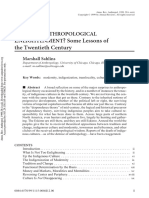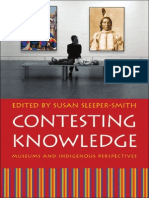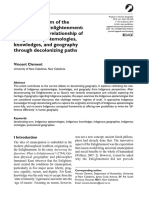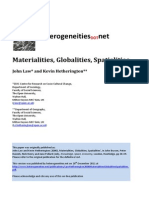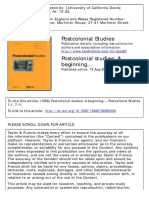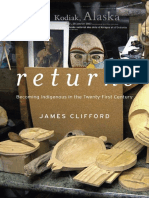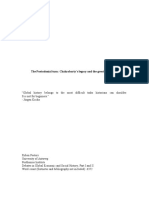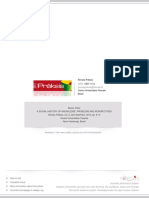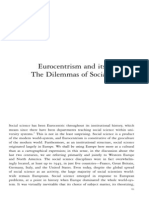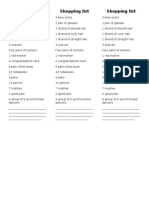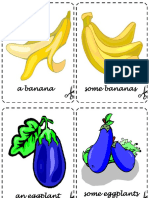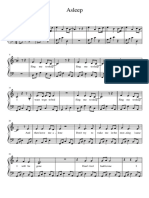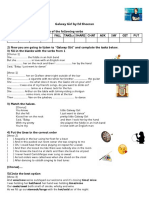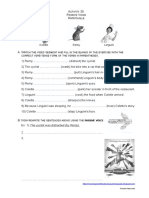0 ratings 0% found this document useful (0 votes) 75 views 9 pages Colonizing Knowledge
Copyright
© © All Rights Reserved
We take content rights seriously. If you suspect this is your content,
claim it here .
Available Formats
Download as PDF or read online on Scribd
Go to previous items Go to next items
Save Colonizing Knowledge For Later CHAPTER 3
Colonizing Knowledges
We bane « history of people putting Moort under 2 micrscope in the came may 2
science leaks at on tse. The ones doing the leaking are ging thssseles the poner
to define
Merate Mia!
In the previous chapter the metaphor of an archive was used to convey
the sense by which the West drew upon a vast history of itself and
muhiple waditions of knowledge which incorporate cultural views of
reality, of time and space. This chapter axgues that the form of
imperialism which indigenous peoples are confronting now emerged
from that period of European history known as the Enlightenment. The+
Enlightenment provided the spirit, the impemus, the confidence, and the
political and economic stractares that facilitated the search for new
knowledges. The project of the Enlightenment is often referred t0 35
‘modernity’ and itis that project which is claimed to have provided the
stimulus for the industrial revolution, the philosophy of iberalisea, the
development of disciplines in the sciences and the development of
public education. Imperialism underpinned and was exitical to these
developments. Whilst imperialism is often thoughe of as a syscem which
drew everthing back into the centre, ir was also a system which
distibured meterials and ideas outwards. Said’s notion of ‘positional
superiority’ is useful here for conceptualizing the ways ia which know-
ledge and culture were as much part of imperialism as raw materials and
military strength. Knowledge was also there to be discovered, extracted,
appropsiated and distributed. Processes for enabling these things ©
‘occur became organized and systematic. They not only informed the
field of study referved co by Said as ‘Orientalism’ but other disciplines
of knowledge and ‘regimes of truth’. It is through these disciplines that
the indigenous world has been rspresented to the West and it is through
these disciplines thar indigenous peoples often research for the fragments
se
COLONIZING KNOWLEDGES 39
of ourselves which were taken, catalogued, stadied and stored. It is not
the intention of this chapter to tell the history of Western knowledge
but rather to draw that history down into the colonized woud, show the
relationship between knowledge, zesearch and imperialism, and then
discuss the ways in which it has come co structuse our own ways of
knowing, through the development of academic disciplines and through.
the education of colonial elites and indigenous or ‘sative’ intellecmals.
‘Western knowledge and science are “beneficiasies’ of the colonization of
indigenous peoples. The knowledge gained through our colonization has
been used, in turn, to colonize us in what Ngugi wa Thiong’o calls the
colonization ‘of the mind’?
Establishing the Positional Supesiority of Wester Knowledge
“The project of modemaity signalled the ead of feudalism and absolutise
sothorigy, legitimated by divine rule, aad announced the beginning of
the modern stare. The new stats formation had to meet the requirements
of an expanding economy based on major improvements ia production.
‘The industeal revolution changed and made new demands upon the
individual and the poltiesl system. The modezn state vas wrested fom
the old regime of absolutise monarchs by the articulation of liberal
politcal and economic theories” As a system of ideas, lberaism focuses
fn the individual, who bas the capacity to season, on a society which
promotes individual abtonomy and sel&interest, and on a state which
hias a sadonal rule of law which regulates public sphere of life, bat
which allows individeals to pursue their econdmie selfinterest, Once it
vwas accepted that bumans Fad che capacity to reason and to attain this
potential dhrough education, through « systematic form of organizing
knowledge, thea it became possible to debate these ideas in rstional and
‘scientific’ ways.
‘The development of scientific thought, the exploration and
‘discovery’ by Europeans of other worlds, the expansion of trade, che
establishment of colonies, and the systematic colonization of indigenous
peoples in the eighteenth and nineteenth centuries are all facets of the
modemist project. Medemism is more than a representation of
fiagmens from che cultural archive in aew coatexts,‘Discoveres’ about
and from the ‘new’ world expanded and challenged ideas the West held
about itself The production of knowledge, new Knowledge and
transformed ‘old’ knowledge, ideas about the nature of knowledge and
the validiy of specific forms of knowledge, became as mach
commodiscs of colonial” exploitetion as other naturil resources
Indigenous peoples were classified alongside the flora and fauna;
hierarchical ypologies of humanity aad systems of representation were�60 DECOLONIZING METHODOLOGIES
fuelled by new discoveries; and cultaral maps were charted and
teritoties limed and contested by the major Buropean powers. Hence
some indigenous peoples were ranked above others in tezms of such
things as the bela? that they were ‘neatly burmarr, ‘almost human’ or
‘sob-human’. This often depended on whether ic was chought that che
peoples concerned possessed a ‘soul and could thesefore be ‘offered
Ecivation and whether or aot they were educable and could be offered
Schooling, These systems for aganting, cassifing and storing acwr
Knowledge, and for theotiring the meinings ‘of such discoveries,
constiated research. In a colonial context, however, this esearch was
adeniably also about power sad domisacon. ‘The instruments or
cechnologies of ‘esearch were also insromenss of knowledge and
insumments for Jegidmating various colonial practices.
“The imaginary line beroeen ‘east and ‘est, raw in 1493 by a Papal
Bull, allowed for che pola] division of the world and the stugle by
competing Western staes to evtblich what Sad has refered (0 as @
“fenible positonel supedority over the known, and yet to become
known, world This postional supedority was contested at several lovls
by European powers, These imaginary boundaries were dcawn again in
Berlin in 1954 when European powers sot around the table once moze
to catve up Afsica and other parts of thei? empires, They contioue 10
be redsawn, Impediliam aad colonialism are the specific formadons
through which the West came to ‘set’, to ‘name’ and to ‘know
jndigenovs commonities. The caltural sichive ‘with its. systems of
representation, codes for unlocking systems of lassifcation, and
Hagmented artefacts of knowledge enabled travelers and observers 0
rake sense of what they saw and to represent their new-found
knowledge back to che West through the authorship and authority of
their repeesenations.
‘While colonialism at an economic level, incloding ies olimate
expression through siavey, opened op new auterials for explokation
tnd new markers for tide, at a cultoral level, ideas, images aod
experiences abour the Other helped to shape and delineate the essential
Aifferences besween Eusope and the fest. Notions about she Other,
‘which already existed in the European imagination, were secast
the framework of Enlightenment philosophies, che iadustcal revolotion
and the scientific ‘discoveries’ of the eighteenth and nineteenth
Centuries, "When disousing the scientific foundations of Westem
research, the indigenous coatsibution to these Soundations is rarely
mentioned, To have acknowledged their conuibaon would, in erms
Of the rules of research practice, be as legitimate as acknowicdging the
‘contribution of a variety of plant, a sherd of pottery or a preserved head
of a native to research. Fusthermore, scoording to Bazin, “Europeans
7? conomizine KNOWLEDGES a
could not even imagine that other people could exer-have done things
‘before or better than themselves.’ The objects of zesearch do not have
‘a voice and do not contsbute to sesearch or science. In fact, the logic
Of the argument would suggest that it is simply impossible, ridiculous
leven, 10 suggest that the object of research can contribute to anything.
‘An object has no life force, no humanity, no spirit ofits own, so there
fore §P cannot make an active contibution. This perspective is not
deliberately insensitive; itis simply chat the rules did.notallow such a
thought 2 enter the scene. Thus, indigenous Asian, American, Pacific
and Aftican forms of knowledge, systems of classification, technologies
and codes of social life, which began to be recorded in some detail by
the seventeenth century, were regarded as ‘new discoveries’ by Western
science These discoveries vere commodified as property belonging to
the calcul archive and body of knowledge of the West?
‘The cighteeoth and nineteenth centaries also constituted an ea of
highly competitive ‘collecting. Many indigenous people might call cis
‘stealing? rather than ‘collecting’. This included the collecting of tesri-
tories, of new species of flor and fauna, of mineral resources and of
cultures. James Clifford, for example, refers to ethnography as a science
which was
12) form of culture collecting ... which) highlights the ways char diverse
experiences and facs are selected, gathered, deached fiom their orginal
temporal occasions, aod given chdusing value in a acw arrangement.
Collecing ~ at least ia the West, where time is generally thought to be
lincar and icreverible ~ implies 4 rescue of phenomena fom inevitable
historical decay or Joes!"
“The idea that collecrors were actualy rescuing artefacts from decay and
destruction, and from indigenous peoples themselves, legiimated
practices which also inchided commercial tade and plain and simple
theft. Cleasy, in corms of teade indigenous peoples were often active
erticipants, in some cases delivering ‘made to order’ goods. The
different agendas and sivalsies of indigenous groups were also known £0
have been incorporated into the commercial activities of Europeans.
Hence, muskets could be traded and then ued to pursue traditional
‘enemics or one group of people could be used to caprare and assis ia
the enslavement of another group who were also hex traditional rivals.
Indigenous property is stil said to be housed in ‘collections’, which in
rum are housed either in museums or private guleses, and art and
artefacts ae often grouped and clasified in the aame of ther ‘collector.
These collections have become the focus of indigenous peoples’
attempts to reclaim ancestal remains and other cultura items (kaowa
in the West as ‘artefacts) belonging to their people.�oe DECOLONIZING METHODOLOGIES
Ie is important to remember, however, that colonialism was sot just
about collection. It was also about rearrangement, re-presentation and
re-distribution. For example, plant species were taken by Joseph Banks
for the Royal Botanic Gardens at Kew. Here they could be ‘grown,
studied, and disbursed to the colonia! stations, « centre of plant transfers,
‘on the scientific level, and of the generation and publication of know-
ledge about plants’. The British Empire became a global laboratory fox
zesearch aad development. New species of plants and animale were
Inwoduced to the colonies to facilitate development and to ‘strengthen’
indigenous species. This point is worth remembering as it contrasts with,
the view, sometimes refered co as a diffusionist explanation, that
Knowledge, people, flora and fauna simply disbursed themselves around
the world. This botanical colonization had already been successfully
cactied out in other places: for example, maize, sweet potatoss, and
tobacco from South America had been widely diseribured. In the centre
of this collection and distribution network was the imperial ‘home’
country. The colonies were peripheral sutellizes which gained access 29
these new knowledges and technologies through ‘recourse to the
‘writiags of authors in the centre’? One effect of this system of
redistribution was the interference caused by new species to the
ecologies of their new environments and the eventual extinction of
several species of bitd and animal life. In the case of New Zealand,
Checeyl Smith argues that, ecologically, the indigenous world was
colonized by weeds.
‘Among the cther significant consequences of ecological impecialism
~ carsied by humans, as well as by plants and animals — were the viral
and bacterial diseases which devastated indigenous populations. This
devastation or genocide was, in the accounte of many indigenous
peoples, used deliberately as a weapon of war. Stories aze told in Canada,
for example, of blankets used by smallpox vietims being sent into First
Nation communities while che soldiers and seulers camped outside
‘waiting for che people to.die, There were several ideologies which
legitimated the Western impact on indigenous health and well-being.
‘These supported sacial views already in place but which in the later
sinezcenth cearuny became increasingly legiimated by the ‘scientific’
‘views of social Danwinisn. The concept of the ‘survival of the Sites?
used to explain the evolution of species in the natural world, was applied
‘enthusiastically wo the human world. It became a very powerful belief
that indigenous peoples. were inherently weak and therefore, at some
point, would dic out. There were debates about how this could be
prevented, for example, chrough miscegenation and cultural assimilation,
and whether this, in fact, was ‘desirable’. judgements on these issues
circled back or depended upon prior considerations 25 to whether she
i
COLONSZING KNOWLEDGES 8
indigenous group concemed had souls, could be saved, and also could
be redeemed culturally. Induential debates on these matters by Catholic
scholars such as Bartolome de Las Casas took place dusing the sitecath
century. In nineteenth-centucy New Zealand some of the debates delved
ght down into che supposed fecundity rates of indigenoas women and
the beter prospects fo: zaial survival if miscegenation occusred. There
‘were very serious scientific views put forward (0 accouat for the demise —
of the indigenous populations. Some views included: sterility caused by
the ‘Tcentionsaess’ of the women, 2 vegetable diet, infanticide and
abortion. Other causes were put down to # sense of hopelessness’ and
lack of spirit, which came about through contact with ‘cvlization’?
Bur there were also state polices (Federal, provineial and local) of
‘enign neglect’ which involved minimal invervenson (the ‘infected
blanke? strategy) while people suffered and died. There were also more
proactive policies based around such ideas as “Manifest Destiny’ which
sanctioned the taking of indigenous lands by aay means.* Ward
Churchill and other indigenous writers classify these actions as part of
the Columbian legacy of genocide.” In relation to the diseases and dis-
case which the West is said to have introduced to indigenous peoples,
the bigger question has always been the extent co which the impact of
disease is an inevitable consequence of contact with the West. The signifi
cance of the issues which this question raises emerges when we examine,
jin a later chapter, the world-wide search cuereatly being undertaken
amongst indigenous populations for genetic solutions to Wessern dis-
‘eases. Aborigine activist Bobbi Sykes has an ‘acid tes?’ for the Western
impacs of indigenous health which consists of ewo lists one 2 list of
diseases introduced by Europeans to Aboriginal people, che other a list of
diseases introduced by Aboriginal people 20 Europeans. There are 20
items listed on the second list. That empty space tells avery potent so
‘The globalization of knowledge and Western culture constantly
sealfirms the West's view of itself as the centre of legitimate knowledge,
the arbiter. of what counts as knowledge and the source of ‘civilized?
Knowiedge. This form of global knowledge is generally referred to as,
‘universal knowlege, svailable to al and not zealy ‘owned’ by anyone,
thar is, uatl non-Western scholars make claims to it. When aims bike
that are made history is revised (again) so, that the story of civilization
remains the story of the West. For this purpose, the Mediterranean
‘world, the basin of Arabie culture and the lands east of Constantinople
are conveniently appropriated as part of the story of Western civilization,
‘Western philosophy and Western knowledge. Through imperialism,
however, these cultures, peoples and their nation siases were re.
positioned as ‘oriental, oF ‘outsider in order wo legitimate the imposition
of colonial rale. For indigenous peoples from other places, the real

